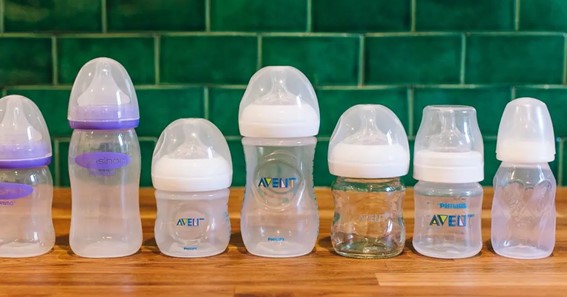Introduction
It can be tough to choose a bottle or teat because there are so many different brands available. Here is a summary to help you determine what will be best for you and your child.
The use of Bisphenol A (BPA) in baby bottles has been prohibited by the European Commission since 2011. The reason for this was worries that the chemical would seep out of the plastic and be ingested by infants. BPA shouldn’t be present in any of the bottles being sold in the UK.
Which baby bottle brand is the best?
Is a common question asked by parents. The truth is that there isn’t any independent research demonstrating that particular brands of bottles or teats have a different ability or pattern for feeding babies. You and your baby must decide what is best for you. Here is a list of the most common bottle types on the market today:
- Simple bottles
These bottles are the norm; they frequently have a narrow, cylindrical shape. They are usually fairly priced and usually come with their own teats and covers. Although they are frequently accessible, filling these bottles with a small neck can be more difficult.
Click here – Which time is best for job search in Dubai?
- Bottles with antibiotics
These bottles are more expensive, and they are made in a way that should lessen the probability of colic symptoms. To lessen the quantity of air eaten, these bottles typically contain air vents, tubes, or foldable bags for the milk. Since there is no independent study available, it is difficult to determine whether these actually make a difference.
You may have heard that you should maintain the milk teat full to prevent ingesting air. However, indigestion or gas is more likely to occur when the milk flow is excessively rapid and not under your baby’s control. According to anecdotal evidence, babies whose parents pace feeding experience less flatulence.
Although some parents find these bottles beneficial, not all babies respond to them, so using them is not a guarantee of recovery. However, they could be more difficult to clean.
- Breathable bottles
Although these bottles are shorter and wider than the standard ones, the same amount of milk can be placed inside of them. They often have a self-sealing lid and silicone teats rather than latex.
These bottles can be simple to fill and clean, which is one benefit of utilising them. On the other side, they may occupy more room in a steriliser, making it unlikely that you can sterilise as many bottles at once.
- Prepared-to-feed bottles
You must use water at about 70 degrees to destroy any potential bacteria because the powdered formula is not sanitary. The nutritious value of the powder may be reduced if the water is too hot, but the bacteria may not be killed if the water is too cold. Bottles labelled “Ready-to-feed” contain sterile, ready-made milk.
If parents have been instructed to give their baby bottle maker formula on medical advice, ready-to-feed bottles can be a convenient short-term alternative. However, they are more expensive and bad for the environment.
Your local hospital could ask you to bring these kinds of bottles in if you intend to use the formula right away because the majority lack the space or amenities to disinfect bottles. Please consult your midwife.
Which teat should I to use?
Siliconeis used to make teats. Compared to latex, which needs to be replaced frequently, silicone is less flexible but more resilient.
Due to the possibility of developing a latex allergy, some parents are wary about using rubber teats, especially if there is a family history of latex sensitivity.
When selecting a bottle teat for your infant from the wide variety available on the market, it can be very difficult. They differ in the size of the nipple and the base breadth. There is no independent data to support some claims that they are more breast-like or resemble the feeling of breastfeeding.
A teat that is better suited for timed bottle feeding might be used. This means that it won’t need to be tipped up so your baby can reach the milk; instead, it will hold enough milk while held in a horizontal posture.
Conclusion
Choosing a teat that will encourage your kid to open their mouth wide and take in the entire teat rather than just the tip may be helpful if you are mixed feeding (feeding from both a bottle and the breast). Babies are encouraged to expand their mouths wide and cup their tongues around the teat by those with a medium wide base and a short to medium nipple length. It’s well-described in this article.
Click here – The Complete guide for Purchasing a Wardrobe
